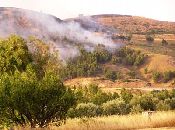| Analysis of results |
 |
|
Using common methods of bio-physical and socio-economic analysis, the results of the field trials in all study sites were examined to see what effects they had on production, culturally, ecologically and off-site. Bio-physical analysis The monitoring strategy used in Research Theme 4 allowed direct comparison between (normalized) time series of, for instance, soil moisture or sediment loss. Variables were generally soil physics related (moisture) or chemistry related (fertility and salinity). Crop yields were measured for arable farming and vegetation density and quality were measured for rangeland type environments. The study sites that focused on a catchment level (such as the forest fire analysis in Portugal) used catchment results to draw conclusions.
Bio-physical effects only make sense within the wider context of the study site. An increase of 30 mm in soil moisture per year may be significant in one setting (where for instance the grazing capacity and fodder quality is increased) but not enough in another which depends on certain crops. The full effect of implementing a change in practice depends on many specific environmental, economic and socio-cultural details.
The last section on impact was used to evaluate the DESIRE field experiments. In WOCAT QT a technology is compared to an untreated reference situation. By means of a large series of questions the benefits and disadvantages with respect to the 0-situation are appraised. These effects are evaluated in 4 levels of change: 0-5%; 5-20%; 20-50% and >50% (decrease or increase).
The questionnaires were filled in by the site coordination teams because many of the questions required specialist knowledge (especially to quantify the level of change). However the teams had many discussions with the stakeholders during and after the experiments so it was felt that the evaluation was not biased towards any particular experiment. In several cases the results of the experiments were counterintuitive or disappointing, and this was noted objectively.
|
||||||||

Acknowledgement
The DESIRE project was
|
DESIRE brought together the expertise of
26 international research institutes
and non-governmental organisations.
This website does not necessarily
represent the opinion of the
European Commission. The European
Commission is not responsible for
any use that might be made of the
information contained herein. 



